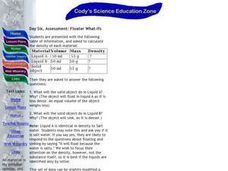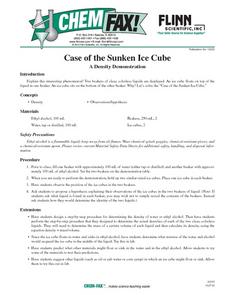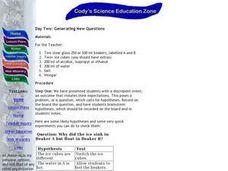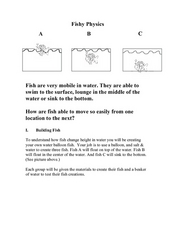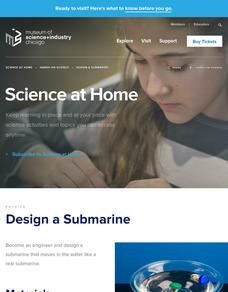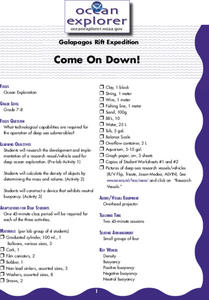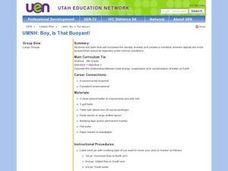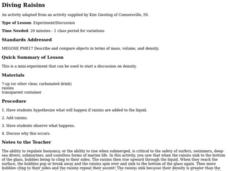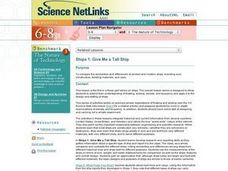Curated OER
How Does the USS Alabama Float?
Students investigate buoyancy. In this buoyancy lesson, students apply the Archimedes Principle of Buoyancy to the experiment conducted in class to determine how battleships float.
Curated OER
Diving Raisins
Students hypothesize and observe what occurs when raisins are dropped in a carbonated liquid. They examine buoyancy and how density effects ascent and descent.
Curated OER
Day Six: Floater What Ifs
Students observe earth science by examining results from an experiment. In this buoyancy lesson, students practice floating different items in two different liquids and identify why certain objects will float and others sink. Students...
Curated OER
Properties of Matter: "Sink or Swim"
Third graders recognize that different materials have different properties which can be observed such as texture and bouyancy, and compare and contrast, through observation, ability of some objects to float because of action of...
Curated OER
Chemistry: The Case of the Sunken Ice Cube
Students examine a density demonstration involving ice cubes and beakers of water and alcohol. After observing how one ice cube floats in water and sinks in alcohol, they determine which mixture of the two would suspend the ice cube in...
Curated OER
What Floats Your Boat?
This open-ended boat building exercise is meant to be part of a three-lesson series on ships. Links to the other two lessons are included. This particular part is mostly a group lab activity in which they build a boat, find its load line...
Curated OER
Sink It
Introduce your class to the concept of sinking and floating. In groups, they classify objects after making predictions about which materials will sink or float. They record their results and create graphs and charts to share with the class.
Curated OER
Day Two: Generating New Questions
Students investigate buoyancy by participating in a lab experiment. In this density instructional activity, students utilize vinegar and alcohol in beakers and attempt to float different items in them. Students analyze which items float...
Curated OER
Fishy Physics
Students explore how fish are able to move easily from one depth to another in water. In this fish instructional activity students create their own balloon fish.
Curated OER
How to Float an Egg
Use the scientific method to experiment with an egg. Your class can examine buoyancy and density by finding how many spoons of salt are needed to float an egg. They can predict, experiment, record data, and analyze results.
Curated OER
The Buoyancy Factor
Students examine why some objects float in water while others sink and the ability of something to float does not depend entirely on its weight. Archimedes' principle is introduced and buoyant force is discussed. Practice calculations...
Museum of Science
Design a Submarine
Don't just sink the boat. Using a closed container as a submarine, pupils experiment to see what to add to the container to make it float, sink to the bottom, and hover in the middle. After finding one option, learners see if they can...
Curated OER
Science: Floating and Sinking Objects
Second graders discuss why some objects float while others sink. They examine various objects and predict whether or not they will sink or float. Students discover the properties needed for objects to float.
Curated OER
Does Soap Float?
Students form hypotheses and carry out an investigation in order to answer a central question: Does soap float? The focus of this activity is on scientific inquiry, but it incorporates scientific topics such as sinking and floating.
Curated OER
Galapagos Rift Expedition Come On Down!
Students research the development and implementation of a research vessel/vehicle used for deep ocean exploration. In this oceanography lesson, students calculate the density of objects by determining the mass and volume.
Curated OER
What Boat Designs Float the Best?
Fifth graders investigate buoyancy by conducting a science experiment. In this water properties lesson, 5th graders predict which of their different paper boat designs will float for the longest period. Students conduct the...
Curated OER
Boy, Is That Buoyant!
Fourth graders see that salt increases the density of water and creates a condition wherein objects are more buoyant than would be expected under normal conditions. They describe the relationship between heat energy, evaporation and...
Curated OER
What Floats Your Boat?
Learners discover the Archimedes principle through a buoyancy experiment. They measure the water displacement of a lump a clay which is denser than water then reshape the clay into a bowl which floats but displaces more water.
Curated OER
Diving Raisins
Students participate in a mini lab to explore density. In this density instructional activity students view a demonstration and answer questions.
Curated OER
Marine Debris on the Chesapeake Bay
Students use website to study estuarine debris data. They study the density of marine debris.
Curated OER
Float Your Boat
Students design an experiment to find density using Archimedes' Principle. In this physics lesson plan, students calculate density using mass and volume. They share their findings in class.
Curated OER
Condiment Diver: The World's Simplest Cartesian Diver
Middle schoolers explain what density is in their own words. In this physics lesson, students perform the condiment experiment and explain why some float and some sink. They share their findings in class.
Teach Engineering
Rock and Boat
Present the class with a question on whether the water level of a pond will rise they take a large rock out of a boat and drop it into the pond. Groups come down on all sides of the question and try to justify their answers. The activity...
Curated OER
Give Me a Tall Ship
Sixth graders develop an understanding of floating, sinking, density, and buoyancy and apply it to the design of testing of ships.
Other popular searches
- Density and Buoyancy Test
- Volume, Density and Buoyancy
- Heat, Density and Buoyancy
- Volume Density and Buoyancy
- Heat Density and Buoyancy
- Buoyancy and Density
- Density Buoyancy Terms
- Density Buoyancy Viscosity
- Buoyancy Density




